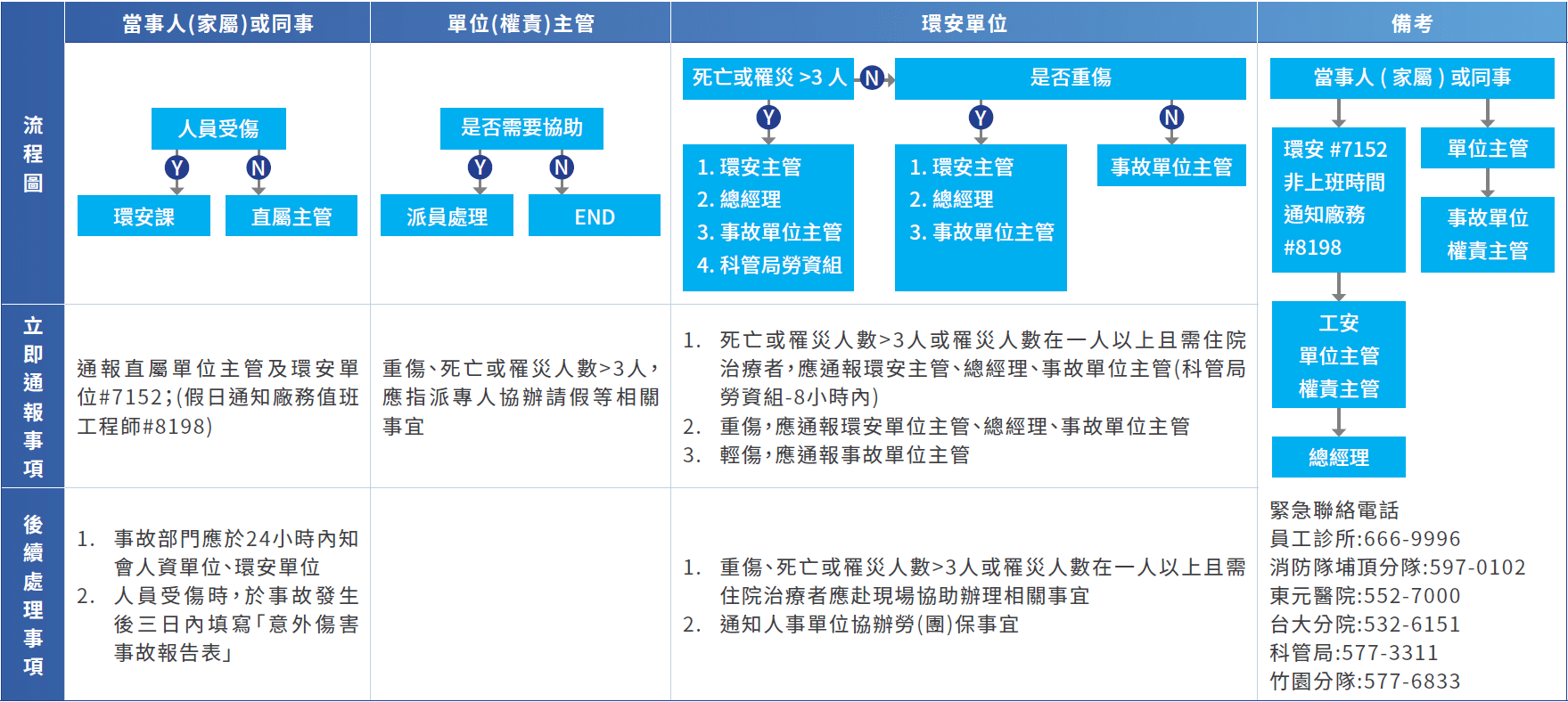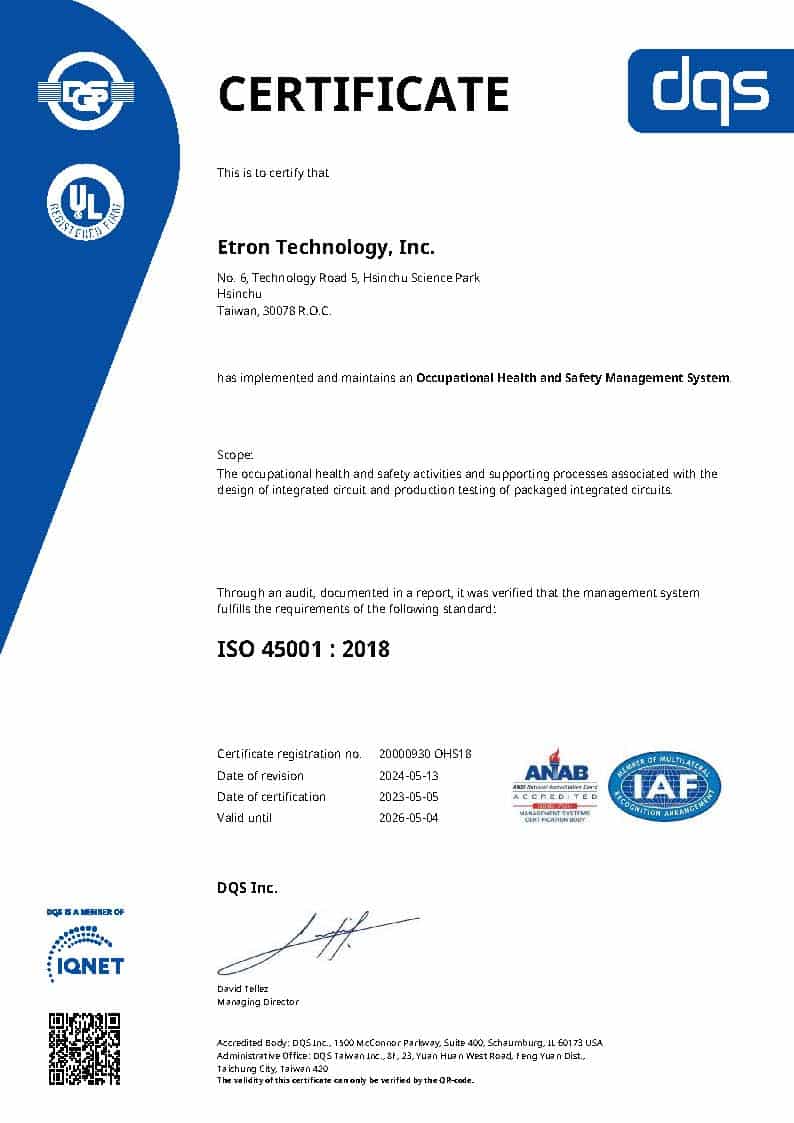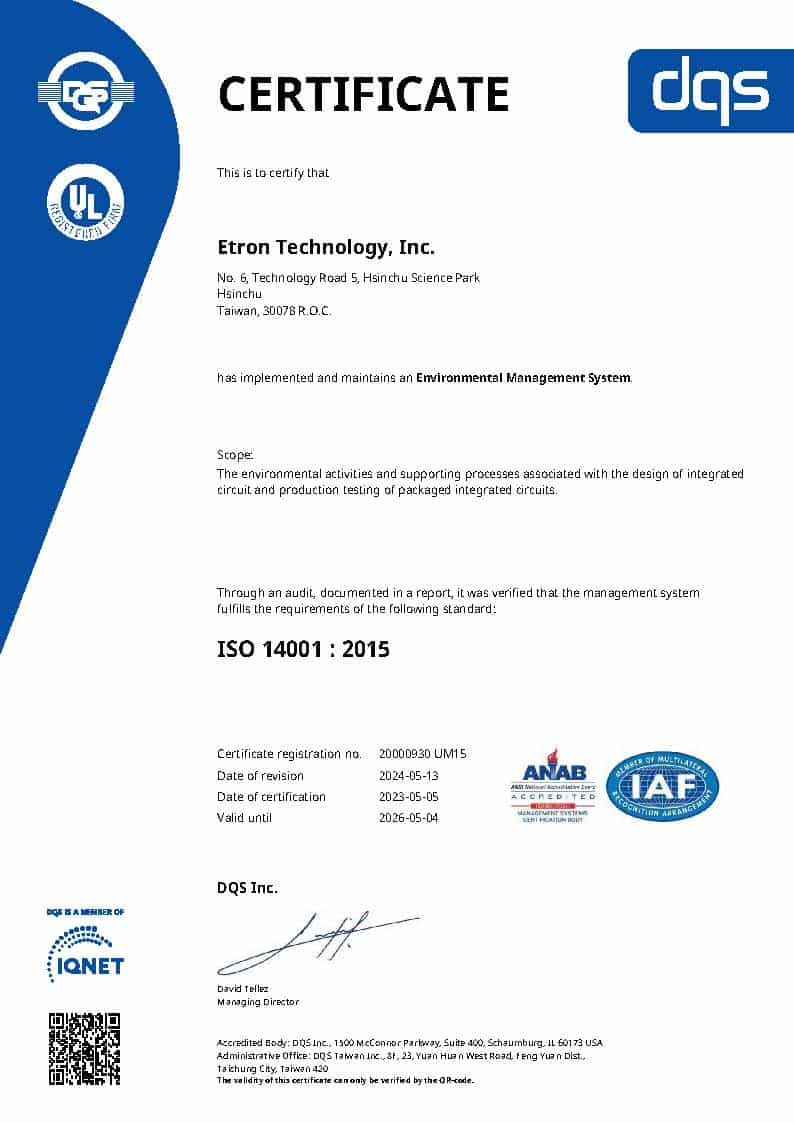|
Sustainability Performance Indicators |
2025 Target | 2026 Target | 2030 Target |
| Number of Occupational Injuries | 0 cases | 0 cases | 0 cases |
| Occupational Disease Rate (ODR) | 0% | 0% | 0% |
| Follow-up Rate of Employees with Moderate or Above Abnormal Health Check Results | 100% | 100% | 100% |
| Abnormal Rate of Employee Blood Lipids / Blood Pressure / Blood Glucose Monitoring | 100% | 100% | 100% |
| Number of Health Promotion Courses | 4 sessions | 4 sessions | 4 sessions |
Occupational Safety and Health Management
Etron Technology has passed and effectively operates the Occupational Safety and Health Management System (ISO 45001:2018), and has established an Occupational Safety and Health Committee to coordinate and promote various safety and health management initiatives. The committee is chaired by the Occupational Safety and Health Management Representative and includes one executive secretary. Committee members consist of department supervisors, safety personnel, engineering technicians, plant medical personnel, and worker representatives, with worker representation exceeding one-third as required by law. The committee convenes quarterly to review and evaluate occupational injury investigations, workplace environment monitoring, and health management measures, continuously strengthening safety and health performance and fostering a safe and healthy work environment.
Implementation Measures
- Risk assessment and control of workplace environments and operating methods
- Maintenance, inspection, and improvement of machinery, electrical, and fire safety equipment
- Safe use, labeling, and storage of hazardous chemicals
- Sampling, monitoring, and improvement of workplace environments
- Safety assessment and management of contractor operations
- Safety and health management of procurement and operational changes
- Establishment of various safety and health management and operating standards
- Regular inspections, key inspections, work checkpoints, and on-site patrols
- Safety and health education and training
- Management of personal protective equipment and epidemic prevention supplies
- Health examinations, tiered management, and health promotion activities
- Collection, sharing, and utilization of safety and health regulations and related information
- Development and drills of emergency response plans for safety and health incidents
- Investigation and statistical analysis of occupational injuries, near misses, and incidents affecting physical or mental health
- Safety and health records management and performance evaluation
- Fire safety, access control, and surveillance management
- Establishment of complaint hotlines, mailboxes, and the safety and health committee to enable employee consultation and participation
Safety and Health Training
Etron Technology values the cultivation of a strong safety culture and provides diversified occupational safety and health training programs, including general safety and health education for new hires and current employees, hazard communication, fire safety training, emergency response drills, as well as specialized certification training (such as safety personnel, first aid responders, organic solvent supervisors, confined space supervisors, high-pressure gas equipment operators, and small boiler operators) and health promotion courses. In addition, contractors are informed of hazards and provided safety briefings to strengthen awareness and reduce occupational risks.
In 2024, a total of 342 participants attended occupational safety training, accumulating 420.5 training hours.
–
Workplace Hazard Identification and Risk Assessment
Etron Technology has established a hazard identification management procedure to ensure effective implementation of hazard identification and risk assessment. Department heads identify and register potential safety and health hazards associated with company activities, facilities, processes, and services (including suppliers and contractors), and describe energy use, raw materials, machinery and equipment, risk sources (unsafe behaviors and conditions), and external factors affecting worker health and safety. The process evaluates risks from both routine operations and operational changes. High-risk items are approved by the Occupational Safety and Health Management Representative and incorporated into safety and health objectives, implemented by responsible units, and tracked quarterly by the Occupational Safety and Health Committee.
The company primarily engages in office-based operations, and the potential occupational disease is overwork. In addition, Etron has established an incident reporting and investigation procedure to ensure proper management of incidents, including the documentation of near misses and policies enabling workers to leave situations they believe may cause injury or illness. When occupational incidents occur, reporting and corrective actions are executed per regulations. Investigation reports are submitted to the committee and announced on the company intranet. The Occupational Safety and Health Committee reviews improvement effectiveness quarterly.
–
Emergency Response Measures
Etron Technology has established an emergency response plan, formed an emergency response command center, and organized emergency response teams. In the event of an emergency, the response team carries out emergency actions. Drill results show all teams successfully completed tasks such as fire extinguishing, first aid, evacuation guidance, and emergency evacuation. New employees receive emergency response education and fire drills every six months. Through simulation exercises, employees develop emergency response and safety management capabilities, enabling timely actions before a crisis escalates. Employees also receive training from the fire department on fire escape and first aid.
In 2024, Etron conducted emergency response drills in accordance with the emergency response plan, including on-site command, communication, rescue notification, evacuation guidance, and safety personnel coordination. The drills help ensure employees can respond quickly during emergencies to reduce injuries and environmental impacts.
–
Incident Investigation Procedure

–
Occupational Incident Statistics
Year | 2024 | 2023 | 2022 | |
Total Working Hours | 760,933 | 687,272 | 603,448 | |
Fatal Work-related Injuries / Fatal Occupational Injuries | Cases | 0 | 0 | 0 |
Ratio | 0 | 0 | 0 | |
Severe / Serious Work-related Injuries | Cases | 0 | 0 | 0 |
Ratio | 0 | 0 | 0 | |
Recordable Work-related Injuries | Cases | 0 | 0 | 0 |
Ratio | 0 | 0 | 0 | |
Occupational Diseases | Cases | 0 | 0 | 0 |
Ratio | 0 | 0 | 0 | |
Recordable Occupational Diseases | Cases | 0 | 0 | 0 |
Ratio | 0 | 0 | 0 | |
Healthy Workplace
In response to social and economic changes, the International Labour Organization (ILO) and the World Health Organization (WHO) advocate for workers’ fundamental right to access workplace safety and health services. Etron Technology aligns with these principles and relevant regulations, proactively planning and implementing workplace health management measures across three key areas: health services, health education, and healthy work environment. The company regularly conducts disease prevention campaigns, health promotion activities, hygiene seminars, preventive health consultations, and health checkups, providing risk assessment, management, and improvement recommendations to employees, ensuring workplace health risks are managed and promoting employee well-being.
To strengthen the workplace health service system and protect physical and mental well-being, Etron Technology systematically promotes health knowledge campaigns and creates a health-friendly, sustainable work environment. Employees are encouraged to adopt positive health practices, maintain mind-body balance, and integrate health management into daily life, achieving holistic work-life well-being.
In alignment with the National Health Agency’s healthy diet policy, the company provides low-fat, low-salt meals to reduce chronic disease risk. The 2024 employee satisfaction survey indicated broad support for these measures. Moving forward, the company will continue to optimize healthy meal programs, leveraging dietary management to promote cardiovascular health and contribute to workplace health and ESG objectives.
–
Employee Health Checkup
Regarding maternal health protection, abnormal workload, and human factor hazard prevention, a total of 534 assessments were conducted in 2024, among which 14 cases of abnormal workload were classified as medium risk. The remaining areas had no medium or high-risk cases. For medium-risk employees, the occupational health team provided follow-up care and arranged on-site physicians for consultation and evaluation, adjusting work arrangements to mitigate health risks.
The company conducts annual occupational health checkups, implementing risk-based classification for key items and providing personalized health guidance, disease prevention education, and follow-up assessments. In 2024, 276 employees completed health checkups, all meeting statutory check frequency requirements, and no cases of occupational disease or suspected occupational disease were found, demonstrating robust employee health risk management and compliance.
Additionally, the company provides healthy meals, exercise facilities, and actively organizes health promotion programs. It has been evaluated by the Ministry of Health and Welfare and awarded the Healthy Promotion Certification Mark (2025–2027), reflecting the company’s ESG commitment to employee well-being and health management practices.
–
Environment, Safety and Health (ESH) Policy
-
To comply with government laws and regulations, abide by international environmental safety and health and energy-related trends and green product regulations and other relevant requirements
-
To reduce energy consumption to reduce Greenhouse Gas (GHG) emissions, thereby increasing carbon reserves
-
To encourage the use of environmentally friendly packaging materials and resource recycling to reduce resource consumption
-
To provide a safe and healthy working environment to reduce the risks that personnel are exposed to when performing operations in the workplace
-
To continue to communicate and expand consultation and participation with employees, suppliers and the public, and implement policies on environmental safety, health, energy and green product management
Contractor Management
- Define clear safety and health requirements in work contract
- Examine safety and health, educate and announce hazard notification before operation
- Supervise and control during operation
- Hold cross-team meetings to align, adjust work contents and in-sync communication when group working
Emergency Response
Developed emergency response plans, such as fires, natural disasters (earthquake and typhoon), power outages, gas leaks, chemical leaks and major infectious diseases. Relevant protective equipments are in place. Emergency response drills have been conducted periodically.
Fire Safety
- Arrange fire safety facility inspection with nonconformity declaration periodically
- Conduct various fire fighting trainings and evacuation drills
- Form emergency response team and exercise regularly
Earthquake Protection
- Conduct periodic building health check
- Ensure machine arrangement can meet floor load range standards
- Anchor nitrogen cabinets to floor to prevent topple over by earthquakes
Flood Risk
Periodic water sewage cleaning and water pumps setting


